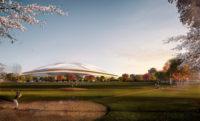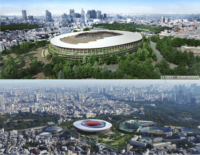Today, government officials in Japan have selected Kengo Kuma’s plan for the 2020 Tokyo Olympic Stadium. The architect submitted the winning proposal along with construction and support firms Taisei Corp. and Azusa Sekkei Co.
The stadium’s steel and latticed wood roof, reaching a height of just over 160 feet, draws on traditional Japanese architecture and would insert the center sports arena below grade. Landscaping figures heavily into the design, with plants and trees planned for exposed terraces that encircle the complex on several levels.
According to The Japan Times, social media users in Japan have already dubbed the stadium the “hamburger.”
On Saturday, a seven-person panel from the Japan Sport Council convened to review the top designs, assessing them for criteria including the expected cost and time of construction. Kuma’s design will cost approximately $1.26 billion; construction is expected to begin as soon as December, 2016, and is scheduled to conclude by November 2019, in time for the Olympics opening ceremony in July 2020.
Previously identified as “design A,” Kuma’s concept for the stadium beat out a plan by 2013 Pritzker Prize winner Toyo Ito. Both finalists’ renderings were first revealed last week, after the scrapping of Zaha Hadid’s original design led to a new competition.
Kuma’s firm, established in 1990, has completed large and small scale commissions, often using wood and other natural materials to reinterpret Japanese building traditions for the 21st century. Past coverage in Architectural Record of his work includes the Tea House in Beijing, retail space for Kayanoya, the soy sauce manufacturer, Teiko University Elementary School, a home in New Canaan, Connecticut, and a remodel of the Nezu Museum.
Rebecca Seidel contributed reporting.










Post a comment to this article
Report Abusive Comment